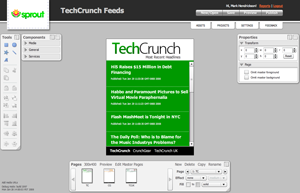A new application called Sprout, launching in private beta at DEMO today, promises to make the creation of Flash applets a whole lot easier.
Sprout is a browser-based, WYSIWYG editor for Flash with an interface reminiscent of Photoshop or Dreamweaver. Designers can use it to create, publish and track Flash widgets, websites and mashups, thereby obviating the need for them to work with programmers who would cost time and money, and who might not execute designs satisfactorily.
The application itself is entirely Flash/Flex-based and won’t require account registration for first-time users (that is, once the private beta period is over). As can be seen in the screenshot to the left, the interface consists of a staging area for construction of a so-called “sprout” (don’t call it a widget!), as well as several panels for tools, components, pages, properties, and more. I found that my experience with Photoshop served me well for creating a sprout (embedded below) that displays TechCrunch feeds, since the same editing concepts are applied by both programs. That said, it would be nice if Sprout had undo capabilities and proper layering, as found in Photoshop.
While all WYSIWYG editors lack at least some of the functionality achievable through direct programming, Sprout overcomes this limitation in part by providing a library of “components” that can be integrated into a given creation. The company has lined up general components such as video, slideshows and RSS feeds in addition to components from 3rd party web services such as Meebo, Yahoo Maps, PollDaddy and Ribbit.
Sprout is marketing its release as a better way for designers to create distributable widgets. The company has partnered up with Clearspring, Gigya, and SpringWidgets to provide both easy distribution and tracking/analytics. Sprout creators can track the usage of not only entire sprouts but the elements, such as buttons, within those sprouts. They can also use the application to make changes to sprouts that have already been distributed across the web.
While Sprout’s current focus is on the widget use case, its capabilities don’t end there. Since you can create sprouts of any dimensions, there’s nothing stopping you from creating entire websites using Sprout. Its pages and linking functionality certainly lend themselves to this type of creation. And since Sprout has incorporated 3rd party services, it can also be used to create mashup pages/portals. The range of possibilities will increase when Sprout releases an SDK in the following month, allowing outside developers to add to the components library.
Sprout should be publicly available in the next few weeks. Until then, the first 200 TechCrunch readers to sign up here will gain access to its private beta. A video demonstration of Sprout is provided below, alongside the RSS feed sprout I created for TechCrunch (hosted on their demo server so it may go down).

